Business Environment & Its Structure
VerifiedAdded on 2020/12/31
|12
|4013
|76
AI Summary
Contribute Materials
Your contribution can guide someone’s learning journey. Share your
documents today.
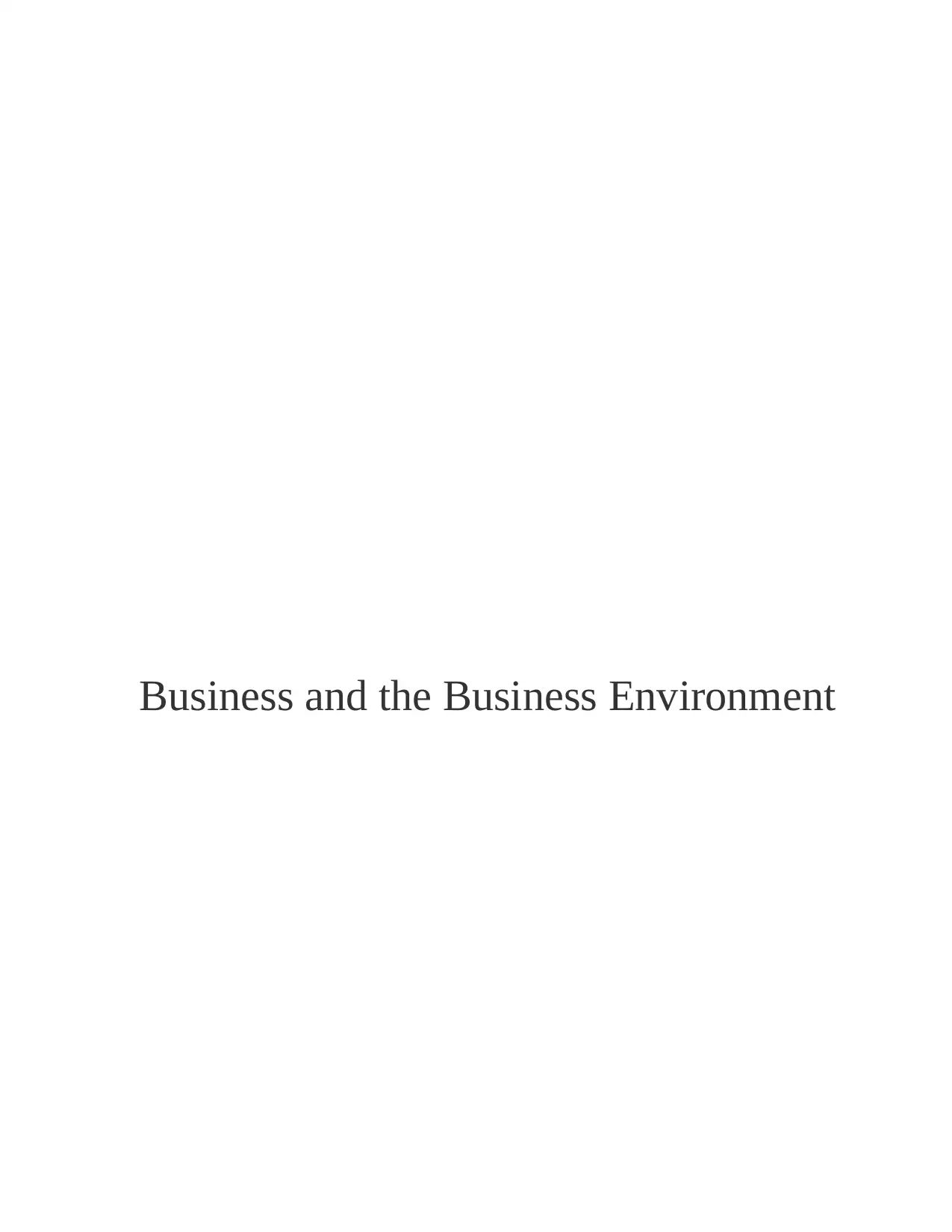
Business and the Business Environment
Secure Best Marks with AI Grader
Need help grading? Try our AI Grader for instant feedback on your assignments.
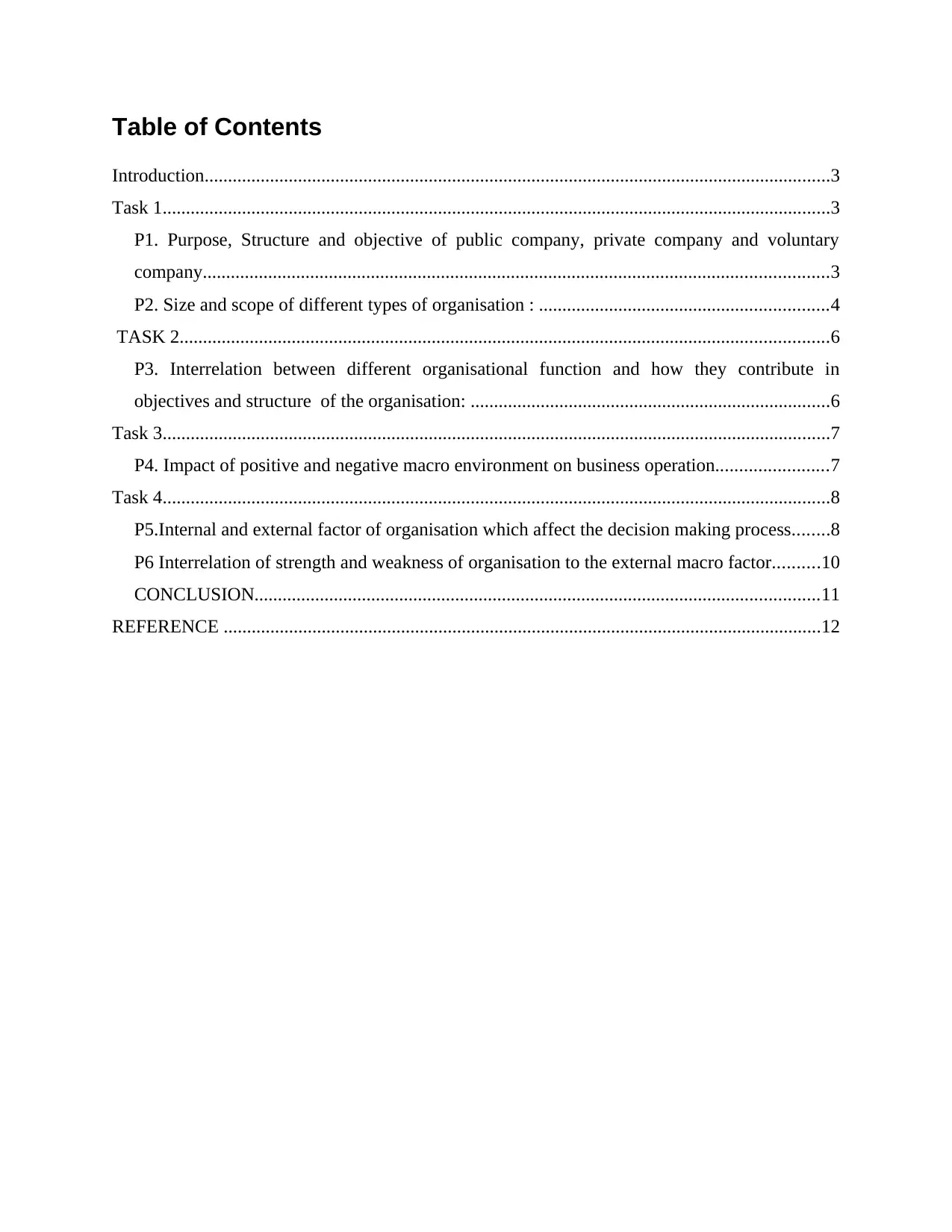
Table of Contents
Introduction......................................................................................................................................3
Task 1...............................................................................................................................................3
P1. Purpose, Structure and objective of public company, private company and voluntary
company......................................................................................................................................3
P2. Size and scope of different types of organisation : ..............................................................4
TASK 2...........................................................................................................................................6
P3. Interrelation between different organisational function and how they contribute in
objectives and structure of the organisation: .............................................................................6
Task 3...............................................................................................................................................7
P4. Impact of positive and negative macro environment on business operation........................7
Task 4...............................................................................................................................................8
P5.Internal and external factor of organisation which affect the decision making process........8
P6 Interrelation of strength and weakness of organisation to the external macro factor..........10
CONCLUSION.........................................................................................................................11
REFERENCE ................................................................................................................................12
Introduction......................................................................................................................................3
Task 1...............................................................................................................................................3
P1. Purpose, Structure and objective of public company, private company and voluntary
company......................................................................................................................................3
P2. Size and scope of different types of organisation : ..............................................................4
TASK 2...........................................................................................................................................6
P3. Interrelation between different organisational function and how they contribute in
objectives and structure of the organisation: .............................................................................6
Task 3...............................................................................................................................................7
P4. Impact of positive and negative macro environment on business operation........................7
Task 4...............................................................................................................................................8
P5.Internal and external factor of organisation which affect the decision making process........8
P6 Interrelation of strength and weakness of organisation to the external macro factor..........10
CONCLUSION.........................................................................................................................11
REFERENCE ................................................................................................................................12
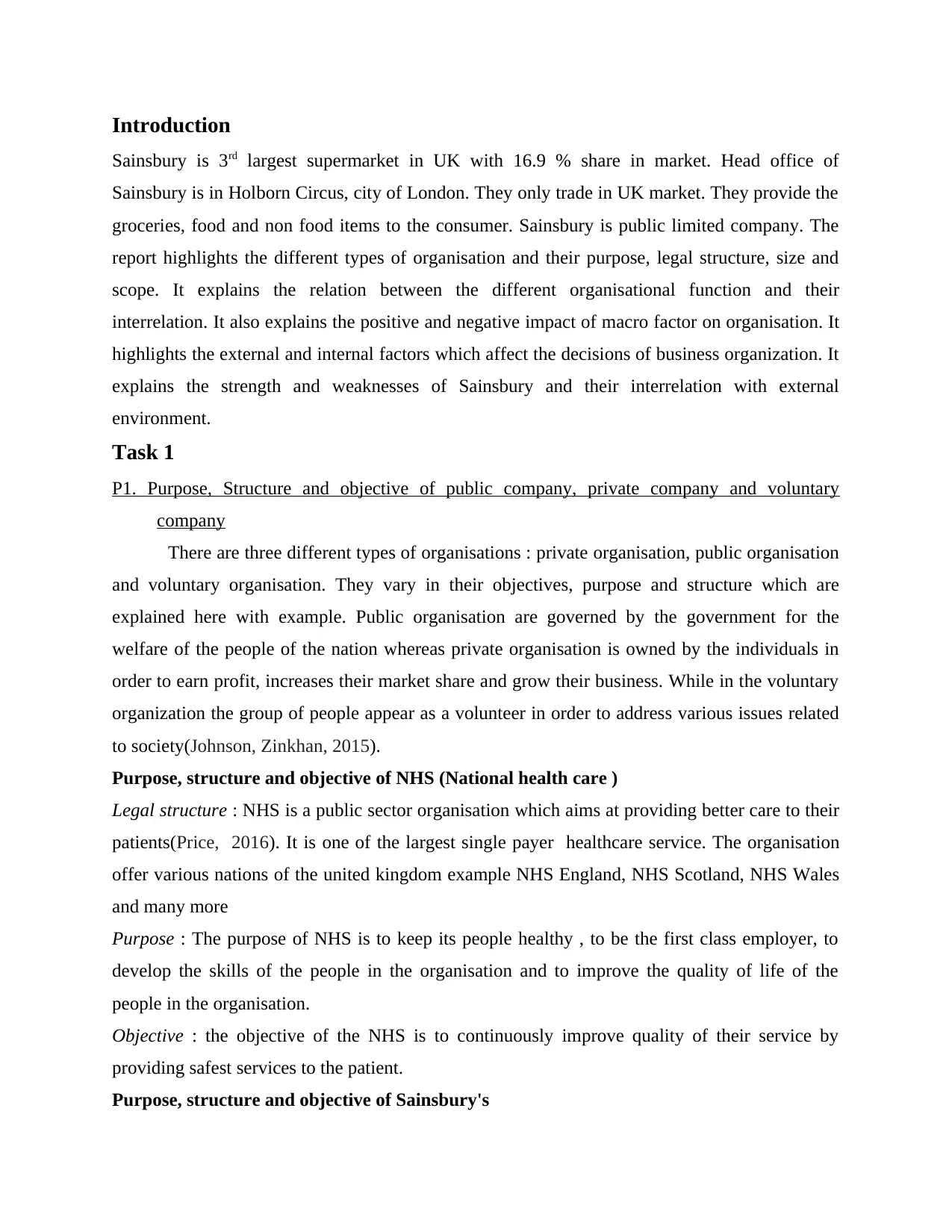
Introduction
Sainsbury is 3rd largest supermarket in UK with 16.9 % share in market. Head office of
Sainsbury is in Holborn Circus, city of London. They only trade in UK market. They provide the
groceries, food and non food items to the consumer. Sainsbury is public limited company. The
report highlights the different types of organisation and their purpose, legal structure, size and
scope. It explains the relation between the different organisational function and their
interrelation. It also explains the positive and negative impact of macro factor on organisation. It
highlights the external and internal factors which affect the decisions of business organization. It
explains the strength and weaknesses of Sainsbury and their interrelation with external
environment.
Task 1
P1. Purpose, Structure and objective of public company, private company and voluntary
company
There are three different types of organisations : private organisation, public organisation
and voluntary organisation. They vary in their objectives, purpose and structure which are
explained here with example. Public organisation are governed by the government for the
welfare of the people of the nation whereas private organisation is owned by the individuals in
order to earn profit, increases their market share and grow their business. While in the voluntary
organization the group of people appear as a volunteer in order to address various issues related
to society(Johnson, Zinkhan, 2015).
Purpose, structure and objective of NHS (National health care )
Legal structure : NHS is a public sector organisation which aims at providing better care to their
patients(Price, 2016). It is one of the largest single payer healthcare service. The organisation
offer various nations of the united kingdom example NHS England, NHS Scotland, NHS Wales
and many more
Purpose : The purpose of NHS is to keep its people healthy , to be the first class employer, to
develop the skills of the people in the organisation and to improve the quality of life of the
people in the organisation.
Objective : the objective of the NHS is to continuously improve quality of their service by
providing safest services to the patient.
Purpose, structure and objective of Sainsbury's
Sainsbury is 3rd largest supermarket in UK with 16.9 % share in market. Head office of
Sainsbury is in Holborn Circus, city of London. They only trade in UK market. They provide the
groceries, food and non food items to the consumer. Sainsbury is public limited company. The
report highlights the different types of organisation and their purpose, legal structure, size and
scope. It explains the relation between the different organisational function and their
interrelation. It also explains the positive and negative impact of macro factor on organisation. It
highlights the external and internal factors which affect the decisions of business organization. It
explains the strength and weaknesses of Sainsbury and their interrelation with external
environment.
Task 1
P1. Purpose, Structure and objective of public company, private company and voluntary
company
There are three different types of organisations : private organisation, public organisation
and voluntary organisation. They vary in their objectives, purpose and structure which are
explained here with example. Public organisation are governed by the government for the
welfare of the people of the nation whereas private organisation is owned by the individuals in
order to earn profit, increases their market share and grow their business. While in the voluntary
organization the group of people appear as a volunteer in order to address various issues related
to society(Johnson, Zinkhan, 2015).
Purpose, structure and objective of NHS (National health care )
Legal structure : NHS is a public sector organisation which aims at providing better care to their
patients(Price, 2016). It is one of the largest single payer healthcare service. The organisation
offer various nations of the united kingdom example NHS England, NHS Scotland, NHS Wales
and many more
Purpose : The purpose of NHS is to keep its people healthy , to be the first class employer, to
develop the skills of the people in the organisation and to improve the quality of life of the
people in the organisation.
Objective : the objective of the NHS is to continuously improve quality of their service by
providing safest services to the patient.
Purpose, structure and objective of Sainsbury's
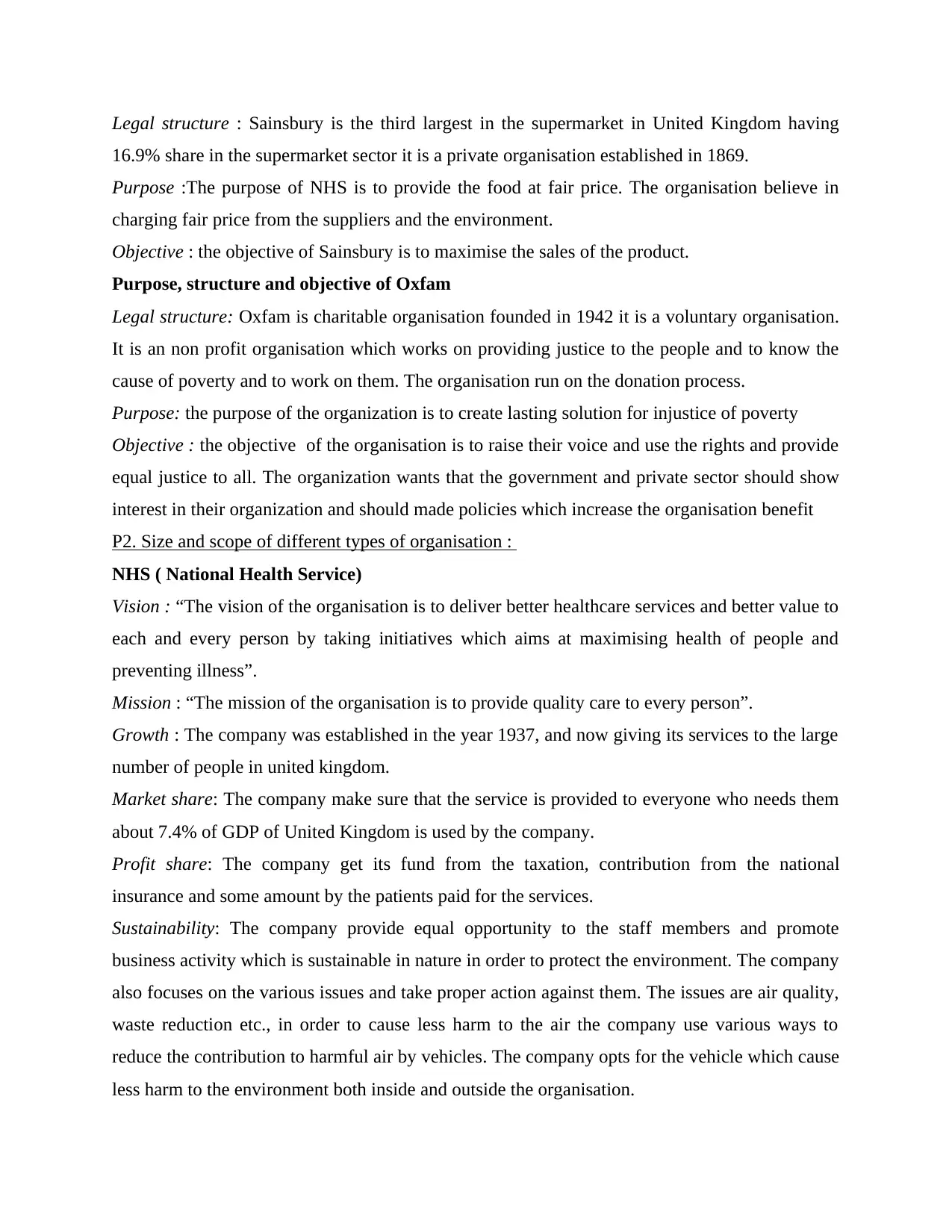
Legal structure : Sainsbury is the third largest in the supermarket in United Kingdom having
16.9% share in the supermarket sector it is a private organisation established in 1869.
Purpose :The purpose of NHS is to provide the food at fair price. The organisation believe in
charging fair price from the suppliers and the environment.
Objective : the objective of Sainsbury is to maximise the sales of the product.
Purpose, structure and objective of Oxfam
Legal structure: Oxfam is charitable organisation founded in 1942 it is a voluntary organisation.
It is an non profit organisation which works on providing justice to the people and to know the
cause of poverty and to work on them. The organisation run on the donation process.
Purpose: the purpose of the organization is to create lasting solution for injustice of poverty
Objective : the objective of the organisation is to raise their voice and use the rights and provide
equal justice to all. The organization wants that the government and private sector should show
interest in their organization and should made policies which increase the organisation benefit
P2. Size and scope of different types of organisation :
NHS ( National Health Service)
Vision : “The vision of the organisation is to deliver better healthcare services and better value to
each and every person by taking initiatives which aims at maximising health of people and
preventing illness”.
Mission : “The mission of the organisation is to provide quality care to every person”.
Growth : The company was established in the year 1937, and now giving its services to the large
number of people in united kingdom.
Market share: The company make sure that the service is provided to everyone who needs them
about 7.4% of GDP of United Kingdom is used by the company.
Profit share: The company get its fund from the taxation, contribution from the national
insurance and some amount by the patients paid for the services.
Sustainability: The company provide equal opportunity to the staff members and promote
business activity which is sustainable in nature in order to protect the environment. The company
also focuses on the various issues and take proper action against them. The issues are air quality,
waste reduction etc., in order to cause less harm to the air the company use various ways to
reduce the contribution to harmful air by vehicles. The company opts for the vehicle which cause
less harm to the environment both inside and outside the organisation.
16.9% share in the supermarket sector it is a private organisation established in 1869.
Purpose :The purpose of NHS is to provide the food at fair price. The organisation believe in
charging fair price from the suppliers and the environment.
Objective : the objective of Sainsbury is to maximise the sales of the product.
Purpose, structure and objective of Oxfam
Legal structure: Oxfam is charitable organisation founded in 1942 it is a voluntary organisation.
It is an non profit organisation which works on providing justice to the people and to know the
cause of poverty and to work on them. The organisation run on the donation process.
Purpose: the purpose of the organization is to create lasting solution for injustice of poverty
Objective : the objective of the organisation is to raise their voice and use the rights and provide
equal justice to all. The organization wants that the government and private sector should show
interest in their organization and should made policies which increase the organisation benefit
P2. Size and scope of different types of organisation :
NHS ( National Health Service)
Vision : “The vision of the organisation is to deliver better healthcare services and better value to
each and every person by taking initiatives which aims at maximising health of people and
preventing illness”.
Mission : “The mission of the organisation is to provide quality care to every person”.
Growth : The company was established in the year 1937, and now giving its services to the large
number of people in united kingdom.
Market share: The company make sure that the service is provided to everyone who needs them
about 7.4% of GDP of United Kingdom is used by the company.
Profit share: The company get its fund from the taxation, contribution from the national
insurance and some amount by the patients paid for the services.
Sustainability: The company provide equal opportunity to the staff members and promote
business activity which is sustainable in nature in order to protect the environment. The company
also focuses on the various issues and take proper action against them. The issues are air quality,
waste reduction etc., in order to cause less harm to the air the company use various ways to
reduce the contribution to harmful air by vehicles. The company opts for the vehicle which cause
less harm to the environment both inside and outside the organisation.
Secure Best Marks with AI Grader
Need help grading? Try our AI Grader for instant feedback on your assignments.
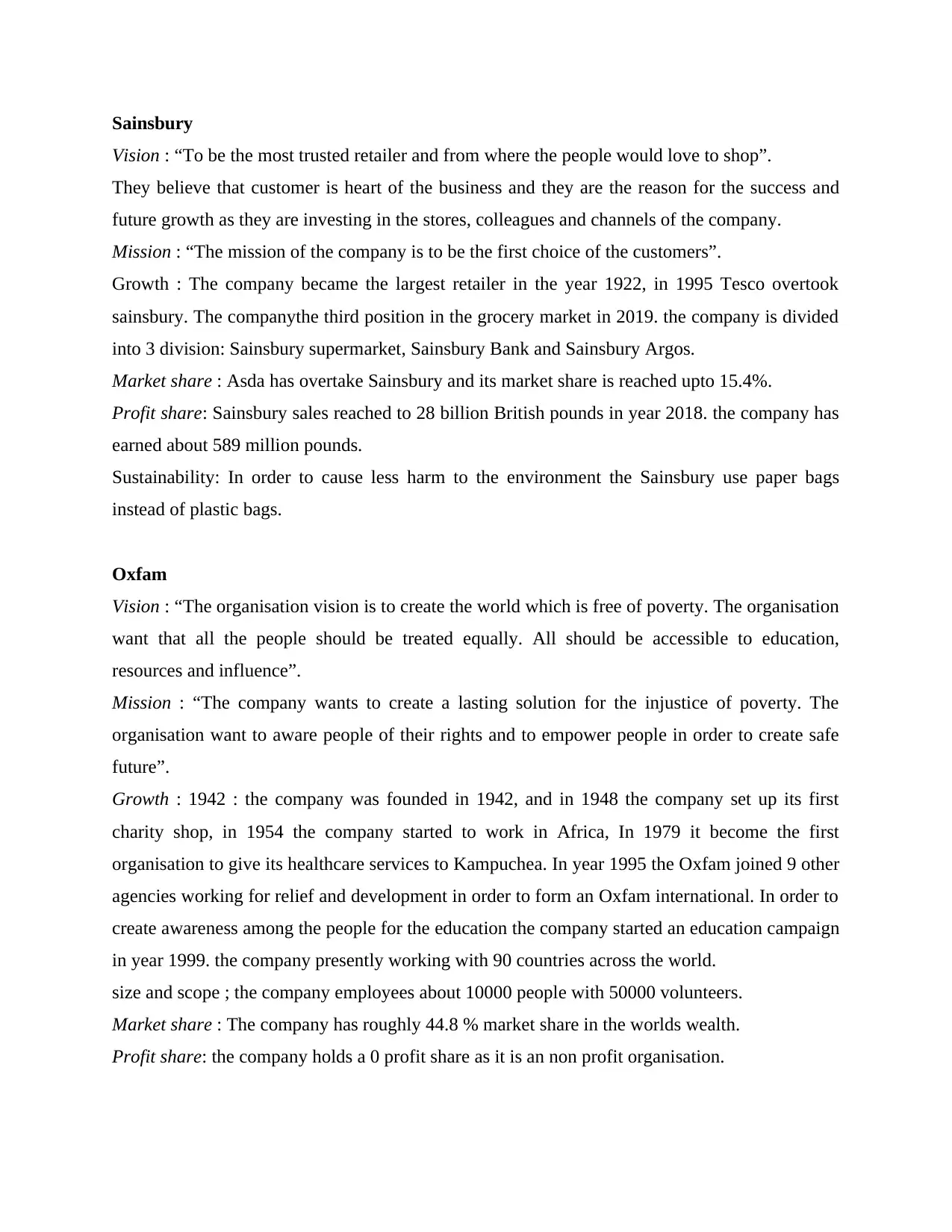
Sainsbury
Vision : “To be the most trusted retailer and from where the people would love to shop”.
They believe that customer is heart of the business and they are the reason for the success and
future growth as they are investing in the stores, colleagues and channels of the company.
Mission : “The mission of the company is to be the first choice of the customers”.
Growth : The company became the largest retailer in the year 1922, in 1995 Tesco overtook
sainsbury. The companythe third position in the grocery market in 2019. the company is divided
into 3 division: Sainsbury supermarket, Sainsbury Bank and Sainsbury Argos.
Market share : Asda has overtake Sainsbury and its market share is reached upto 15.4%.
Profit share: Sainsbury sales reached to 28 billion British pounds in year 2018. the company has
earned about 589 million pounds.
Sustainability: In order to cause less harm to the environment the Sainsbury use paper bags
instead of plastic bags.
Oxfam
Vision : “The organisation vision is to create the world which is free of poverty. The organisation
want that all the people should be treated equally. All should be accessible to education,
resources and influence”.
Mission : “The company wants to create a lasting solution for the injustice of poverty. The
organisation want to aware people of their rights and to empower people in order to create safe
future”.
Growth : 1942 : the company was founded in 1942, and in 1948 the company set up its first
charity shop, in 1954 the company started to work in Africa, In 1979 it become the first
organisation to give its healthcare services to Kampuchea. In year 1995 the Oxfam joined 9 other
agencies working for relief and development in order to form an Oxfam international. In order to
create awareness among the people for the education the company started an education campaign
in year 1999. the company presently working with 90 countries across the world.
size and scope ; the company employees about 10000 people with 50000 volunteers.
Market share : The company has roughly 44.8 % market share in the worlds wealth.
Profit share: the company holds a 0 profit share as it is an non profit organisation.
Vision : “To be the most trusted retailer and from where the people would love to shop”.
They believe that customer is heart of the business and they are the reason for the success and
future growth as they are investing in the stores, colleagues and channels of the company.
Mission : “The mission of the company is to be the first choice of the customers”.
Growth : The company became the largest retailer in the year 1922, in 1995 Tesco overtook
sainsbury. The companythe third position in the grocery market in 2019. the company is divided
into 3 division: Sainsbury supermarket, Sainsbury Bank and Sainsbury Argos.
Market share : Asda has overtake Sainsbury and its market share is reached upto 15.4%.
Profit share: Sainsbury sales reached to 28 billion British pounds in year 2018. the company has
earned about 589 million pounds.
Sustainability: In order to cause less harm to the environment the Sainsbury use paper bags
instead of plastic bags.
Oxfam
Vision : “The organisation vision is to create the world which is free of poverty. The organisation
want that all the people should be treated equally. All should be accessible to education,
resources and influence”.
Mission : “The company wants to create a lasting solution for the injustice of poverty. The
organisation want to aware people of their rights and to empower people in order to create safe
future”.
Growth : 1942 : the company was founded in 1942, and in 1948 the company set up its first
charity shop, in 1954 the company started to work in Africa, In 1979 it become the first
organisation to give its healthcare services to Kampuchea. In year 1995 the Oxfam joined 9 other
agencies working for relief and development in order to form an Oxfam international. In order to
create awareness among the people for the education the company started an education campaign
in year 1999. the company presently working with 90 countries across the world.
size and scope ; the company employees about 10000 people with 50000 volunteers.
Market share : The company has roughly 44.8 % market share in the worlds wealth.
Profit share: the company holds a 0 profit share as it is an non profit organisation.
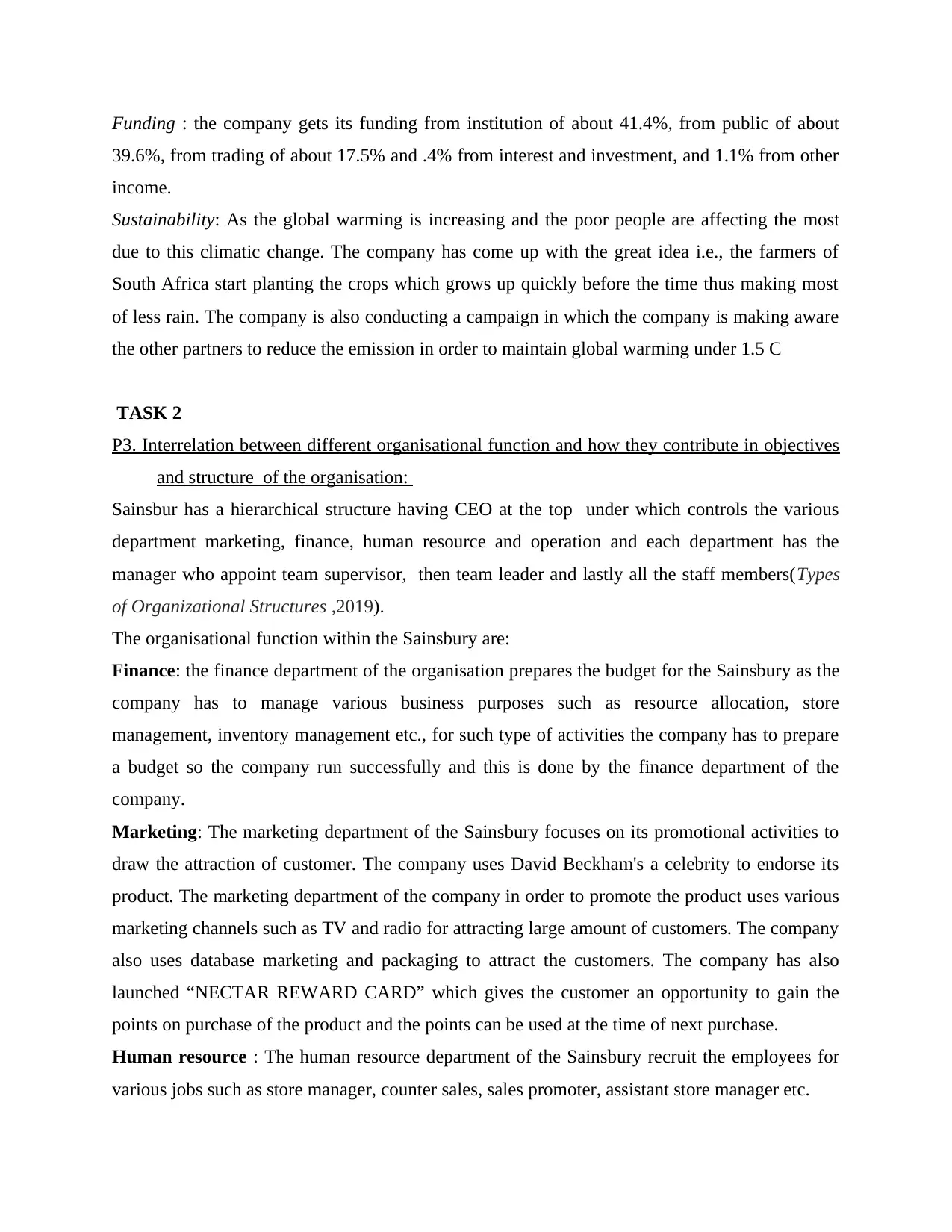
Funding : the company gets its funding from institution of about 41.4%, from public of about
39.6%, from trading of about 17.5% and .4% from interest and investment, and 1.1% from other
income.
Sustainability: As the global warming is increasing and the poor people are affecting the most
due to this climatic change. The company has come up with the great idea i.e., the farmers of
South Africa start planting the crops which grows up quickly before the time thus making most
of less rain. The company is also conducting a campaign in which the company is making aware
the other partners to reduce the emission in order to maintain global warming under 1.5 C
TASK 2
P3. Interrelation between different organisational function and how they contribute in objectives
and structure of the organisation:
Sainsbur has a hierarchical structure having CEO at the top under which controls the various
department marketing, finance, human resource and operation and each department has the
manager who appoint team supervisor, then team leader and lastly all the staff members(Types
of Organizational Structures ,2019).
The organisational function within the Sainsbury are:
Finance: the finance department of the organisation prepares the budget for the Sainsbury as the
company has to manage various business purposes such as resource allocation, store
management, inventory management etc., for such type of activities the company has to prepare
a budget so the company run successfully and this is done by the finance department of the
company.
Marketing: The marketing department of the Sainsbury focuses on its promotional activities to
draw the attraction of customer. The company uses David Beckham's a celebrity to endorse its
product. The marketing department of the company in order to promote the product uses various
marketing channels such as TV and radio for attracting large amount of customers. The company
also uses database marketing and packaging to attract the customers. The company has also
launched “NECTAR REWARD CARD” which gives the customer an opportunity to gain the
points on purchase of the product and the points can be used at the time of next purchase.
Human resource : The human resource department of the Sainsbury recruit the employees for
various jobs such as store manager, counter sales, sales promoter, assistant store manager etc.
39.6%, from trading of about 17.5% and .4% from interest and investment, and 1.1% from other
income.
Sustainability: As the global warming is increasing and the poor people are affecting the most
due to this climatic change. The company has come up with the great idea i.e., the farmers of
South Africa start planting the crops which grows up quickly before the time thus making most
of less rain. The company is also conducting a campaign in which the company is making aware
the other partners to reduce the emission in order to maintain global warming under 1.5 C
TASK 2
P3. Interrelation between different organisational function and how they contribute in objectives
and structure of the organisation:
Sainsbur has a hierarchical structure having CEO at the top under which controls the various
department marketing, finance, human resource and operation and each department has the
manager who appoint team supervisor, then team leader and lastly all the staff members(Types
of Organizational Structures ,2019).
The organisational function within the Sainsbury are:
Finance: the finance department of the organisation prepares the budget for the Sainsbury as the
company has to manage various business purposes such as resource allocation, store
management, inventory management etc., for such type of activities the company has to prepare
a budget so the company run successfully and this is done by the finance department of the
company.
Marketing: The marketing department of the Sainsbury focuses on its promotional activities to
draw the attraction of customer. The company uses David Beckham's a celebrity to endorse its
product. The marketing department of the company in order to promote the product uses various
marketing channels such as TV and radio for attracting large amount of customers. The company
also uses database marketing and packaging to attract the customers. The company has also
launched “NECTAR REWARD CARD” which gives the customer an opportunity to gain the
points on purchase of the product and the points can be used at the time of next purchase.
Human resource : The human resource department of the Sainsbury recruit the employees for
various jobs such as store manager, counter sales, sales promoter, assistant store manager etc.
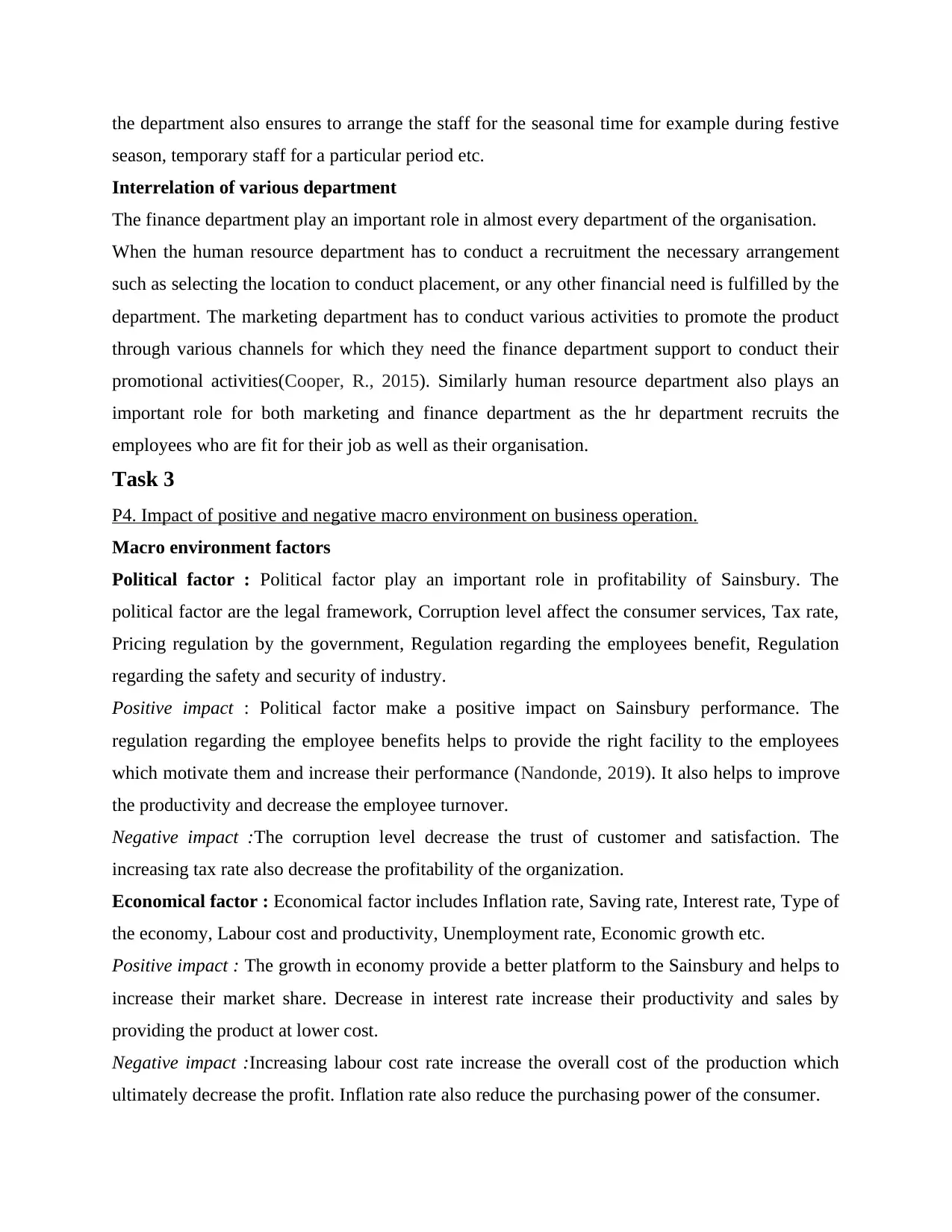
the department also ensures to arrange the staff for the seasonal time for example during festive
season, temporary staff for a particular period etc.
Interrelation of various department
The finance department play an important role in almost every department of the organisation.
When the human resource department has to conduct a recruitment the necessary arrangement
such as selecting the location to conduct placement, or any other financial need is fulfilled by the
department. The marketing department has to conduct various activities to promote the product
through various channels for which they need the finance department support to conduct their
promotional activities(Cooper, R., 2015). Similarly human resource department also plays an
important role for both marketing and finance department as the hr department recruits the
employees who are fit for their job as well as their organisation.
Task 3
P4. Impact of positive and negative macro environment on business operation.
Macro environment factors
Political factor : Political factor play an important role in profitability of Sainsbury. The
political factor are the legal framework, Corruption level affect the consumer services, Tax rate,
Pricing regulation by the government, Regulation regarding the employees benefit, Regulation
regarding the safety and security of industry.
Positive impact : Political factor make a positive impact on Sainsbury performance. The
regulation regarding the employee benefits helps to provide the right facility to the employees
which motivate them and increase their performance (Nandonde, 2019). It also helps to improve
the productivity and decrease the employee turnover.
Negative impact :The corruption level decrease the trust of customer and satisfaction. The
increasing tax rate also decrease the profitability of the organization.
Economical factor : Economical factor includes Inflation rate, Saving rate, Interest rate, Type of
the economy, Labour cost and productivity, Unemployment rate, Economic growth etc.
Positive impact : The growth in economy provide a better platform to the Sainsbury and helps to
increase their market share. Decrease in interest rate increase their productivity and sales by
providing the product at lower cost.
Negative impact :Increasing labour cost rate increase the overall cost of the production which
ultimately decrease the profit. Inflation rate also reduce the purchasing power of the consumer.
season, temporary staff for a particular period etc.
Interrelation of various department
The finance department play an important role in almost every department of the organisation.
When the human resource department has to conduct a recruitment the necessary arrangement
such as selecting the location to conduct placement, or any other financial need is fulfilled by the
department. The marketing department has to conduct various activities to promote the product
through various channels for which they need the finance department support to conduct their
promotional activities(Cooper, R., 2015). Similarly human resource department also plays an
important role for both marketing and finance department as the hr department recruits the
employees who are fit for their job as well as their organisation.
Task 3
P4. Impact of positive and negative macro environment on business operation.
Macro environment factors
Political factor : Political factor play an important role in profitability of Sainsbury. The
political factor are the legal framework, Corruption level affect the consumer services, Tax rate,
Pricing regulation by the government, Regulation regarding the employees benefit, Regulation
regarding the safety and security of industry.
Positive impact : Political factor make a positive impact on Sainsbury performance. The
regulation regarding the employee benefits helps to provide the right facility to the employees
which motivate them and increase their performance (Nandonde, 2019). It also helps to improve
the productivity and decrease the employee turnover.
Negative impact :The corruption level decrease the trust of customer and satisfaction. The
increasing tax rate also decrease the profitability of the organization.
Economical factor : Economical factor includes Inflation rate, Saving rate, Interest rate, Type of
the economy, Labour cost and productivity, Unemployment rate, Economic growth etc.
Positive impact : The growth in economy provide a better platform to the Sainsbury and helps to
increase their market share. Decrease in interest rate increase their productivity and sales by
providing the product at lower cost.
Negative impact :Increasing labour cost rate increase the overall cost of the production which
ultimately decrease the profit. Inflation rate also reduce the purchasing power of the consumer.
Paraphrase This Document
Need a fresh take? Get an instant paraphrase of this document with our AI Paraphraser
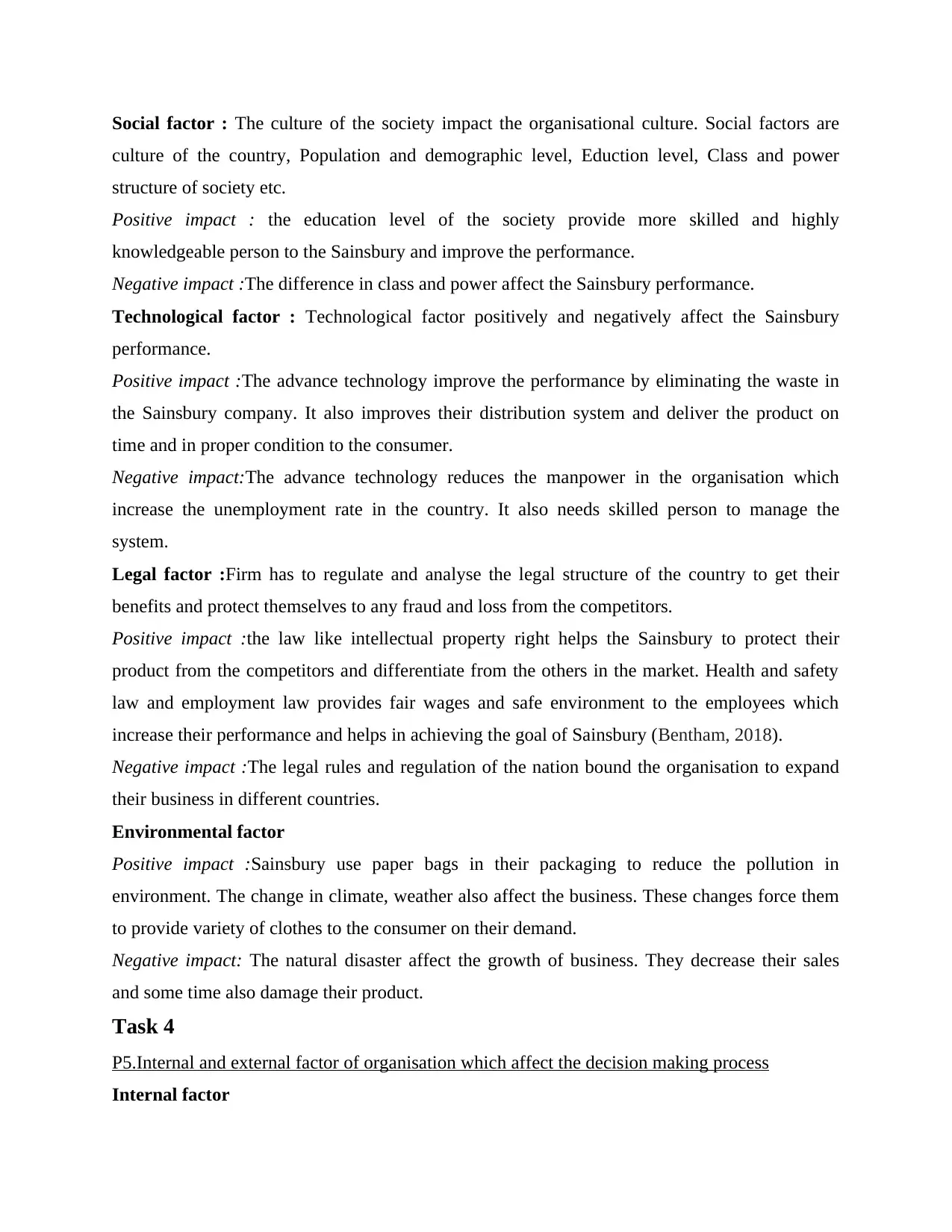
Social factor : The culture of the society impact the organisational culture. Social factors are
culture of the country, Population and demographic level, Eduction level, Class and power
structure of society etc.
Positive impact : the education level of the society provide more skilled and highly
knowledgeable person to the Sainsbury and improve the performance.
Negative impact :The difference in class and power affect the Sainsbury performance.
Technological factor : Technological factor positively and negatively affect the Sainsbury
performance.
Positive impact :The advance technology improve the performance by eliminating the waste in
the Sainsbury company. It also improves their distribution system and deliver the product on
time and in proper condition to the consumer.
Negative impact:The advance technology reduces the manpower in the organisation which
increase the unemployment rate in the country. It also needs skilled person to manage the
system.
Legal factor :Firm has to regulate and analyse the legal structure of the country to get their
benefits and protect themselves to any fraud and loss from the competitors.
Positive impact :the law like intellectual property right helps the Sainsbury to protect their
product from the competitors and differentiate from the others in the market. Health and safety
law and employment law provides fair wages and safe environment to the employees which
increase their performance and helps in achieving the goal of Sainsbury (Bentham, 2018).
Negative impact :The legal rules and regulation of the nation bound the organisation to expand
their business in different countries.
Environmental factor
Positive impact :Sainsbury use paper bags in their packaging to reduce the pollution in
environment. The change in climate, weather also affect the business. These changes force them
to provide variety of clothes to the consumer on their demand.
Negative impact: The natural disaster affect the growth of business. They decrease their sales
and some time also damage their product.
Task 4
P5.Internal and external factor of organisation which affect the decision making process
Internal factor
culture of the country, Population and demographic level, Eduction level, Class and power
structure of society etc.
Positive impact : the education level of the society provide more skilled and highly
knowledgeable person to the Sainsbury and improve the performance.
Negative impact :The difference in class and power affect the Sainsbury performance.
Technological factor : Technological factor positively and negatively affect the Sainsbury
performance.
Positive impact :The advance technology improve the performance by eliminating the waste in
the Sainsbury company. It also improves their distribution system and deliver the product on
time and in proper condition to the consumer.
Negative impact:The advance technology reduces the manpower in the organisation which
increase the unemployment rate in the country. It also needs skilled person to manage the
system.
Legal factor :Firm has to regulate and analyse the legal structure of the country to get their
benefits and protect themselves to any fraud and loss from the competitors.
Positive impact :the law like intellectual property right helps the Sainsbury to protect their
product from the competitors and differentiate from the others in the market. Health and safety
law and employment law provides fair wages and safe environment to the employees which
increase their performance and helps in achieving the goal of Sainsbury (Bentham, 2018).
Negative impact :The legal rules and regulation of the nation bound the organisation to expand
their business in different countries.
Environmental factor
Positive impact :Sainsbury use paper bags in their packaging to reduce the pollution in
environment. The change in climate, weather also affect the business. These changes force them
to provide variety of clothes to the consumer on their demand.
Negative impact: The natural disaster affect the growth of business. They decrease their sales
and some time also damage their product.
Task 4
P5.Internal and external factor of organisation which affect the decision making process
Internal factor
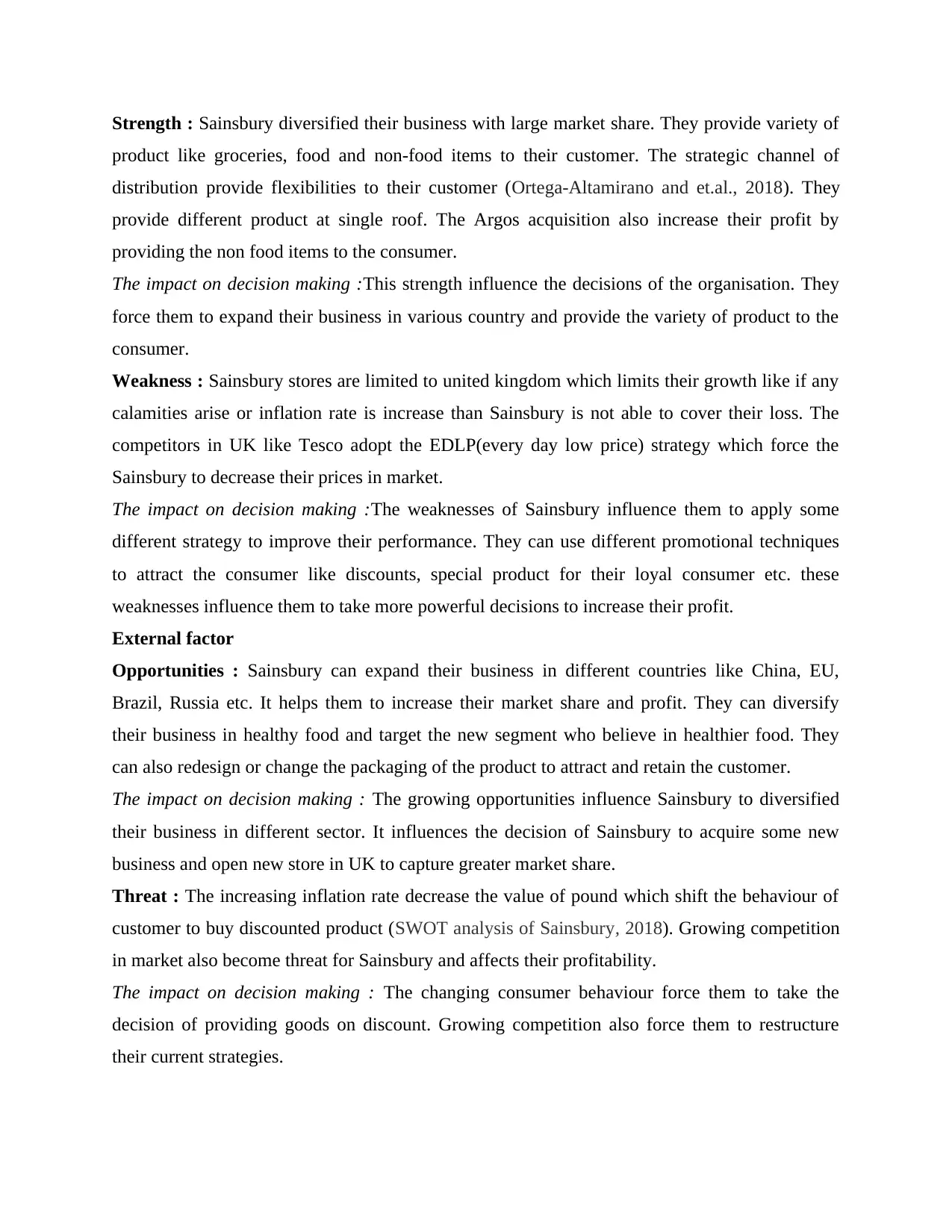
Strength : Sainsbury diversified their business with large market share. They provide variety of
product like groceries, food and non-food items to their customer. The strategic channel of
distribution provide flexibilities to their customer (Ortega-Altamirano and et.al., 2018). They
provide different product at single roof. The Argos acquisition also increase their profit by
providing the non food items to the consumer.
The impact on decision making :This strength influence the decisions of the organisation. They
force them to expand their business in various country and provide the variety of product to the
consumer.
Weakness : Sainsbury stores are limited to united kingdom which limits their growth like if any
calamities arise or inflation rate is increase than Sainsbury is not able to cover their loss. The
competitors in UK like Tesco adopt the EDLP(every day low price) strategy which force the
Sainsbury to decrease their prices in market.
The impact on decision making :The weaknesses of Sainsbury influence them to apply some
different strategy to improve their performance. They can use different promotional techniques
to attract the consumer like discounts, special product for their loyal consumer etc. these
weaknesses influence them to take more powerful decisions to increase their profit.
External factor
Opportunities : Sainsbury can expand their business in different countries like China, EU,
Brazil, Russia etc. It helps them to increase their market share and profit. They can diversify
their business in healthy food and target the new segment who believe in healthier food. They
can also redesign or change the packaging of the product to attract and retain the customer.
The impact on decision making : The growing opportunities influence Sainsbury to diversified
their business in different sector. It influences the decision of Sainsbury to acquire some new
business and open new store in UK to capture greater market share.
Threat : The increasing inflation rate decrease the value of pound which shift the behaviour of
customer to buy discounted product (SWOT analysis of Sainsbury, 2018). Growing competition
in market also become threat for Sainsbury and affects their profitability.
The impact on decision making : The changing consumer behaviour force them to take the
decision of providing goods on discount. Growing competition also force them to restructure
their current strategies.
product like groceries, food and non-food items to their customer. The strategic channel of
distribution provide flexibilities to their customer (Ortega-Altamirano and et.al., 2018). They
provide different product at single roof. The Argos acquisition also increase their profit by
providing the non food items to the consumer.
The impact on decision making :This strength influence the decisions of the organisation. They
force them to expand their business in various country and provide the variety of product to the
consumer.
Weakness : Sainsbury stores are limited to united kingdom which limits their growth like if any
calamities arise or inflation rate is increase than Sainsbury is not able to cover their loss. The
competitors in UK like Tesco adopt the EDLP(every day low price) strategy which force the
Sainsbury to decrease their prices in market.
The impact on decision making :The weaknesses of Sainsbury influence them to apply some
different strategy to improve their performance. They can use different promotional techniques
to attract the consumer like discounts, special product for their loyal consumer etc. these
weaknesses influence them to take more powerful decisions to increase their profit.
External factor
Opportunities : Sainsbury can expand their business in different countries like China, EU,
Brazil, Russia etc. It helps them to increase their market share and profit. They can diversify
their business in healthy food and target the new segment who believe in healthier food. They
can also redesign or change the packaging of the product to attract and retain the customer.
The impact on decision making : The growing opportunities influence Sainsbury to diversified
their business in different sector. It influences the decision of Sainsbury to acquire some new
business and open new store in UK to capture greater market share.
Threat : The increasing inflation rate decrease the value of pound which shift the behaviour of
customer to buy discounted product (SWOT analysis of Sainsbury, 2018). Growing competition
in market also become threat for Sainsbury and affects their profitability.
The impact on decision making : The changing consumer behaviour force them to take the
decision of providing goods on discount. Growing competition also force them to restructure
their current strategies.
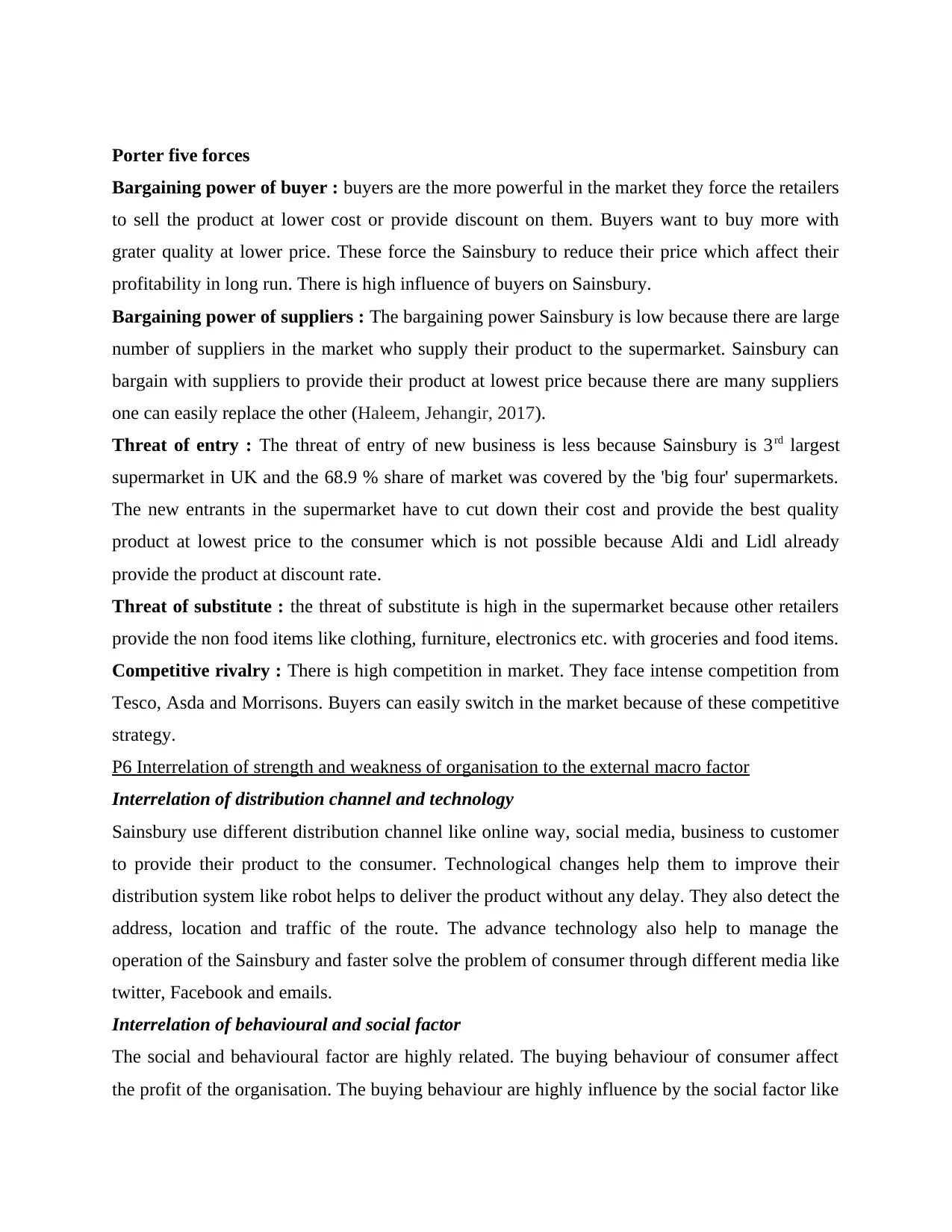
Porter five forces
Bargaining power of buyer : buyers are the more powerful in the market they force the retailers
to sell the product at lower cost or provide discount on them. Buyers want to buy more with
grater quality at lower price. These force the Sainsbury to reduce their price which affect their
profitability in long run. There is high influence of buyers on Sainsbury.
Bargaining power of suppliers : The bargaining power Sainsbury is low because there are large
number of suppliers in the market who supply their product to the supermarket. Sainsbury can
bargain with suppliers to provide their product at lowest price because there are many suppliers
one can easily replace the other (Haleem, Jehangir, 2017).
Threat of entry : The threat of entry of new business is less because Sainsbury is 3rd largest
supermarket in UK and the 68.9 % share of market was covered by the 'big four' supermarkets.
The new entrants in the supermarket have to cut down their cost and provide the best quality
product at lowest price to the consumer which is not possible because Aldi and Lidl already
provide the product at discount rate.
Threat of substitute : the threat of substitute is high in the supermarket because other retailers
provide the non food items like clothing, furniture, electronics etc. with groceries and food items.
Competitive rivalry : There is high competition in market. They face intense competition from
Tesco, Asda and Morrisons. Buyers can easily switch in the market because of these competitive
strategy.
P6 Interrelation of strength and weakness of organisation to the external macro factor
Interrelation of distribution channel and technology
Sainsbury use different distribution channel like online way, social media, business to customer
to provide their product to the consumer. Technological changes help them to improve their
distribution system like robot helps to deliver the product without any delay. They also detect the
address, location and traffic of the route. The advance technology also help to manage the
operation of the Sainsbury and faster solve the problem of consumer through different media like
twitter, Facebook and emails.
Interrelation of behavioural and social factor
The social and behavioural factor are highly related. The buying behaviour of consumer affect
the profit of the organisation. The buying behaviour are highly influence by the social factor like
Bargaining power of buyer : buyers are the more powerful in the market they force the retailers
to sell the product at lower cost or provide discount on them. Buyers want to buy more with
grater quality at lower price. These force the Sainsbury to reduce their price which affect their
profitability in long run. There is high influence of buyers on Sainsbury.
Bargaining power of suppliers : The bargaining power Sainsbury is low because there are large
number of suppliers in the market who supply their product to the supermarket. Sainsbury can
bargain with suppliers to provide their product at lowest price because there are many suppliers
one can easily replace the other (Haleem, Jehangir, 2017).
Threat of entry : The threat of entry of new business is less because Sainsbury is 3rd largest
supermarket in UK and the 68.9 % share of market was covered by the 'big four' supermarkets.
The new entrants in the supermarket have to cut down their cost and provide the best quality
product at lowest price to the consumer which is not possible because Aldi and Lidl already
provide the product at discount rate.
Threat of substitute : the threat of substitute is high in the supermarket because other retailers
provide the non food items like clothing, furniture, electronics etc. with groceries and food items.
Competitive rivalry : There is high competition in market. They face intense competition from
Tesco, Asda and Morrisons. Buyers can easily switch in the market because of these competitive
strategy.
P6 Interrelation of strength and weakness of organisation to the external macro factor
Interrelation of distribution channel and technology
Sainsbury use different distribution channel like online way, social media, business to customer
to provide their product to the consumer. Technological changes help them to improve their
distribution system like robot helps to deliver the product without any delay. They also detect the
address, location and traffic of the route. The advance technology also help to manage the
operation of the Sainsbury and faster solve the problem of consumer through different media like
twitter, Facebook and emails.
Interrelation of behavioural and social factor
The social and behavioural factor are highly related. The buying behaviour of consumer affect
the profit of the organisation. The buying behaviour are highly influence by the social factor like
Secure Best Marks with AI Grader
Need help grading? Try our AI Grader for instant feedback on your assignments.

trend, fashion, demographic and educational level. The demographic factor like gender, age and
income group affect the business of Sainsbury (Hammad, 2015). High income group people
purchase the costlier product to maintain their lifestyle and to fulfil their need.
Interrelation of business acquisition and economic factor
Business acquisition is strength for Sainsbury because it helps to increase the profit of the
business. The acquisition of Argos increase the profit and market share with serve in non food
items. It helps in economic growth by increase the share in GDP.
Interrelation of natural calamities with environmental factor
The natural calamities are the weakness for Sainsbury because they highly affect the business.
Natural calamities damage the products of the retailers and they have to suffer huge loss. The
change in climate like different seasons force the supermarket to provide range of product
according to the season which increase the retention of customer toward the Sainsbury.
CONCLUSION
The study helps us in understanding the various types of organisation i.e., private, public and
voluntary organisation as every company varies from each other in their purpose, objective,
mission and vision. There are different organisational function the study helps to know them and
their interrelation with each other and why they are important to run the business. There are
various factors which affect the working of the business such as new entrants in the market,
change in market demand etc., and the company sometimes has to face failure due to the
companies own weakness which is essential for the company to identify therefore there are
various models such as swot and porter five forces which help the company in analysing such
factors.
income group affect the business of Sainsbury (Hammad, 2015). High income group people
purchase the costlier product to maintain their lifestyle and to fulfil their need.
Interrelation of business acquisition and economic factor
Business acquisition is strength for Sainsbury because it helps to increase the profit of the
business. The acquisition of Argos increase the profit and market share with serve in non food
items. It helps in economic growth by increase the share in GDP.
Interrelation of natural calamities with environmental factor
The natural calamities are the weakness for Sainsbury because they highly affect the business.
Natural calamities damage the products of the retailers and they have to suffer huge loss. The
change in climate like different seasons force the supermarket to provide range of product
according to the season which increase the retention of customer toward the Sainsbury.
CONCLUSION
The study helps us in understanding the various types of organisation i.e., private, public and
voluntary organisation as every company varies from each other in their purpose, objective,
mission and vision. There are different organisational function the study helps to know them and
their interrelation with each other and why they are important to run the business. There are
various factors which affect the working of the business such as new entrants in the market,
change in market demand etc., and the company sometimes has to face failure due to the
companies own weakness which is essential for the company to identify therefore there are
various models such as swot and porter five forces which help the company in analysing such
factors.
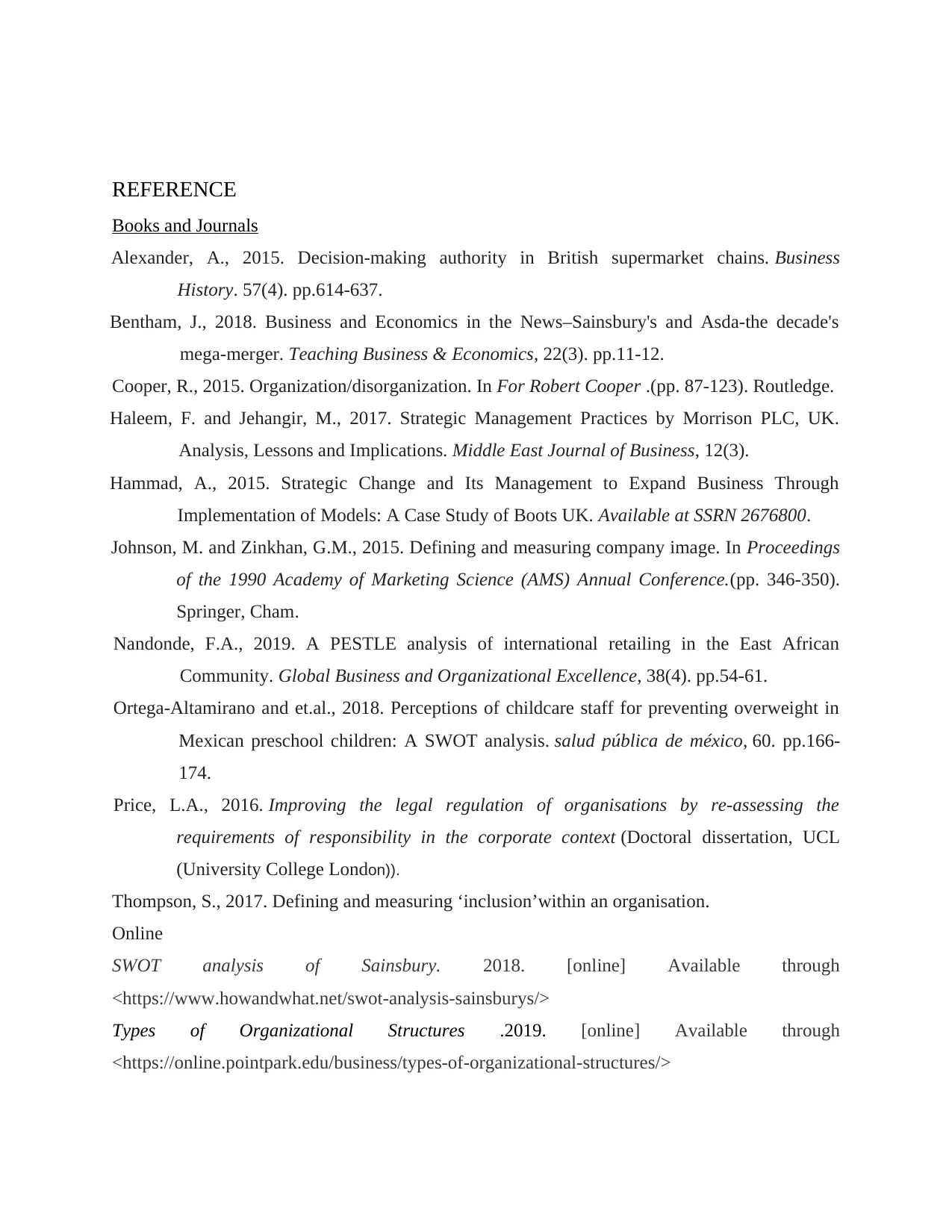
REFERENCE
Books and Journals
Alexander, A., 2015. Decision-making authority in British supermarket chains. Business
History. 57(4). pp.614-637.
Bentham, J., 2018. Business and Economics in the News–Sainsbury's and Asda-the decade's
mega-merger. Teaching Business & Economics, 22(3). pp.11-12.
Cooper, R., 2015. Organization/disorganization. In For Robert Cooper .(pp. 87-123). Routledge.
Haleem, F. and Jehangir, M., 2017. Strategic Management Practices by Morrison PLC, UK.
Analysis, Lessons and Implications. Middle East Journal of Business, 12(3).
Hammad, A., 2015. Strategic Change and Its Management to Expand Business Through
Implementation of Models: A Case Study of Boots UK. Available at SSRN 2676800.
Johnson, M. and Zinkhan, G.M., 2015. Defining and measuring company image. In Proceedings
of the 1990 Academy of Marketing Science (AMS) Annual Conference.(pp. 346-350).
Springer, Cham.
Nandonde, F.A., 2019. A PESTLE analysis of international retailing in the East African
Community. Global Business and Organizational Excellence, 38(4). pp.54-61.
Ortega-Altamirano and et.al., 2018. Perceptions of childcare staff for preventing overweight in
Mexican preschool children: A SWOT analysis. salud pública de méxico, 60. pp.166-
174.
Price, L.A., 2016. Improving the legal regulation of organisations by re-assessing the
requirements of responsibility in the corporate context (Doctoral dissertation, UCL
(University College London)).
Thompson, S., 2017. Defining and measuring ‘inclusion’within an organisation.
Online
SWOT analysis of Sainsbury. 2018. [online] Available through
<https://www.howandwhat.net/swot-analysis-sainsburys/>
Types of Organizational Structures .2019. [online] Available through
<https://online.pointpark.edu/business/types-of-organizational-structures/>
Books and Journals
Alexander, A., 2015. Decision-making authority in British supermarket chains. Business
History. 57(4). pp.614-637.
Bentham, J., 2018. Business and Economics in the News–Sainsbury's and Asda-the decade's
mega-merger. Teaching Business & Economics, 22(3). pp.11-12.
Cooper, R., 2015. Organization/disorganization. In For Robert Cooper .(pp. 87-123). Routledge.
Haleem, F. and Jehangir, M., 2017. Strategic Management Practices by Morrison PLC, UK.
Analysis, Lessons and Implications. Middle East Journal of Business, 12(3).
Hammad, A., 2015. Strategic Change and Its Management to Expand Business Through
Implementation of Models: A Case Study of Boots UK. Available at SSRN 2676800.
Johnson, M. and Zinkhan, G.M., 2015. Defining and measuring company image. In Proceedings
of the 1990 Academy of Marketing Science (AMS) Annual Conference.(pp. 346-350).
Springer, Cham.
Nandonde, F.A., 2019. A PESTLE analysis of international retailing in the East African
Community. Global Business and Organizational Excellence, 38(4). pp.54-61.
Ortega-Altamirano and et.al., 2018. Perceptions of childcare staff for preventing overweight in
Mexican preschool children: A SWOT analysis. salud pública de méxico, 60. pp.166-
174.
Price, L.A., 2016. Improving the legal regulation of organisations by re-assessing the
requirements of responsibility in the corporate context (Doctoral dissertation, UCL
(University College London)).
Thompson, S., 2017. Defining and measuring ‘inclusion’within an organisation.
Online
SWOT analysis of Sainsbury. 2018. [online] Available through
<https://www.howandwhat.net/swot-analysis-sainsburys/>
Types of Organizational Structures .2019. [online] Available through
<https://online.pointpark.edu/business/types-of-organizational-structures/>
1 out of 12
Your All-in-One AI-Powered Toolkit for Academic Success.
+13062052269
info@desklib.com
Available 24*7 on WhatsApp / Email
![[object Object]](/_next/static/media/star-bottom.7253800d.svg)
Unlock your academic potential
© 2024 | Zucol Services PVT LTD | All rights reserved.





